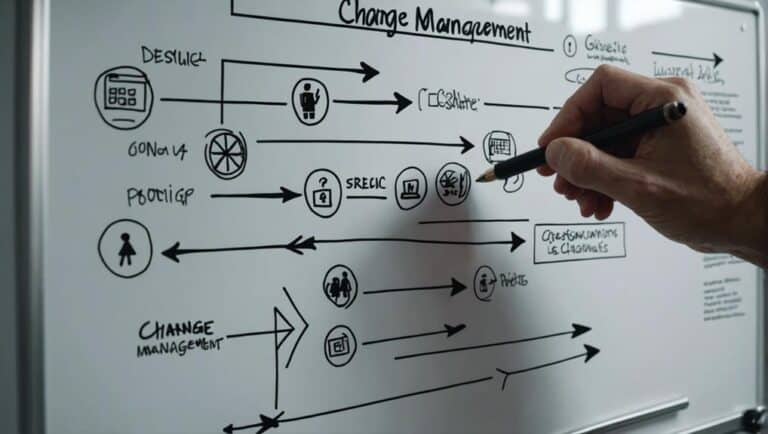In an era where adaptability is synonymous with success, revolutionizing change management reporting is crucial.
This article provides a strategic blueprint for enhancing reporting mechanisms, ensuring that they not only convey key performance metrics but also align with organizational objectives.
We will explore systematic reporting practices that promote accountability, enable precise resource allocation, and facilitate decisive policy integration, equipping leaders with the analytical tools needed to navigate the complexities of change with confidence and control.
Key Takeaways
- Compartmentalize elements of the report with numerical or alphabetical headers
- Address the goals of each change being reported
- List the resources (financial and otherwise) used for current or completed changes
- Summarize how new policies reflect the changes being made
Structuring Effective Reports
While structuring effective reports, it is imperative to compartmentalize various elements with clear headers and a navigable table of contents, ensuring that stakeholders can access the necessary information with ease.
Utilizing data analysis becomes instrumental in distilling complex datasets into comprehensible insights. This analytical approach supports strategic decision-making, propelling an organization towards its objectives with precision.
Presenting visuals, such as charts and graphs, further refines the communication of quantitative findings, enabling stakeholders to grasp the narrative at a glance.
A methodical layout that aligns with organizational goals and the strategic direction emphasizes control, granting readers the ability to efficiently evaluate progress and make informed decisions.
Every element of the report underscores a commitment to clarity, conciseness, and actionable intelligence.
Navigating the Contents
Navigating the contents of a change management report requires meticulous attention to detail, ensuring that every section is purposefully structured to guide stakeholders through the intricacies of the change process. The table of contents should serve as a strategic map, leading the audience through a logical flow of information. The report structure is paramount in achieving control over the data presented.
- Clarity: A well-organized table of contents that directs to clear, concise sections.
- Confidence: Detailed insights that empower stakeholders to make informed decisions.
- Mastery: A methodical layout that enables a commanding grasp of the presented changes.
- Progress: A systematic breakdown of developments that showcases the journey of transformation.
Each element of the report must be crafted to strategically inform and inspire confidence among its readers, allowing for a sense of mastery over the change process and a clear view of progress.
Detailing Change Goals
Establishing clear objectives for each proposed change ensures that stakeholders can discern the strategic intent behind organizational transformations. By meticulously detailing change goals, a report can serve as a strategic blueprint, connecting goals and progress, thereby enabling precise measurement of change impact.
This analytical approach allows for a methodical evaluation of how each milestone contributes to overarching objectives. Stakeholders demand a systematic presentation that not only articulates the goals but also demonstrates how each action aligns with the intended outcomes. It is critical to quantify progress against these goals to provide tangible evidence of success or identify areas needing course correction.
This strategic framework assures stakeholders of a controlled, transparent, and accountable change management process, where every decision is data-driven and geared towards fulfilling the defined objectives.
Understanding Change Significance
Building on the strategic framework of detailed change goals, comprehending the significance of each change ensures stakeholders recognize the broader impacts and the value they add to the organization. A methodical analysis of change impact involves:
- Quantifying Outcomes: Objectively measuring the benefits and consequences of change initiatives.
- Risk Assessment: Identifying potential pitfalls to mitigate against unforeseen complications.
- Communicating Value: Clearly articulating how each change aligns with the organization’s strategic objectives.
- Stakeholder Engagement: Ensuring that the involved parties are informed and supportive of the changes.
This strategic and analytical approach underlines the importance of not only implementing change but also managing and communicating it effectively to maintain a sense of control and direction within the organization.
Tracking Resource Usage
Consistently tracking resource usage is paramount in evaluating the efficiency and cost-effectiveness of change management initiatives. An analytical approach to this task involves systematic assessment of resource allocation against project milestones and outcomes. By employing strategic methods to dissect resource utilization, organizations can identify areas where tracking efficiency can be improved, thus enhancing overall change management processes.
Resource optimization becomes a focal point as it directly impacts an organization’s ability to execute change without excessive expenditure. A methodical review of resource consumption patterns, aligned with change management goals, allows for a precise adjustment of strategies and ensures that resources are leveraged to their maximum potential. This control enables a robust framework for decision-making, where resource allocation is continuously refined to support the dynamic nature of change management.
Financial Reporting Insights
We must scrutinize the financial aspects of change management to provide stakeholders with a transparent and precise understanding of cost implications. A systematic approach to financial analysis is paramount in ensuring that cost management strategies are both effective and efficient. By dissecting the intricacies of financial data, organizations can preemptively identify potential risks and align their budgets accordingly.
- Budget Allocation: Strategically directing funds to maximize change impact.
- Cost-Benefit Analysis: Quantifying the return on investment for each change initiative.
- Expense Tracking: Meticulously documenting every expenditure to avoid financial overruns.
- Forecasting: Using historical data to predict and prepare for future financial needs.
These elements are critical in cultivating an environment where stakeholders feel in command, bolstering their confidence in the change management process.
Aligning With New Policies
Ensuring that each modification adheres to new organizational policies is a pivotal step in advancing effective change management. The analytical framework for aligning with these policies is methodical, requiring a strategic review of the changes vis-à-vis existing guidelines. This process is not merely procedural but foundational in resolving policy conflicts that may arise during transition periods.
A meticulous approach ensures that change initiatives are not only compliant but also reinforce the organization’s strategic direction.
Resolving Policy Conflicts
Navigating policy conflicts is an integral step in refining change management, as it ensures that new initiatives seamlessly integrate with the established regulatory framework of the organization. To achieve policy alignment, consider the following strategic steps:
- Comprehensive Policy Review: Identify discrepancies between existing policies and proposed changes.
- Stakeholder Collaboration: Engage key personnel to discuss and reconcile conflicting policies.
- Policy Amendment Protocols: Develop a clear process for updating policies in alignment with organizational changes.
- Continuous Monitoring: Implement a system to ensure ongoing adherence to modified policies.
Each element is designed to forge a path toward resolving policy conflicts, thereby fortifying the governance structure and maintaining the equilibrium between innovation and control.
Monitoring Progress Updates
The organization’s change management reporting must include a detailed progress updates section, linking milestones to the resolved policy conflicts for a seamless transition.
This strategic inclusion ensures that stakeholders are continually informed about the pace and direction of change, providing a basis for improving communication and measuring impact methodically.
A structured approach to monitoring facilitates the identification of areas requiring additional focus or accelerated efforts.
| Milestone Achieved | Policy Issue Resolved | Impact Measurement |
|---|---|---|
| New System Rollout | Data Protection Policy | Reduced Error Rate |
| Process Optimization | Workflow Regulation | Increased Efficiency |
| Training Completion | Employee Conduct Code | Higher Staff Competency |
Through the analytical examination of progress updates, organizations can proactively manage the dynamics of change, maintaining control over the transformation and its outcomes.
What are the Key Components of Change Management Reporting for a Successful Audit?
When performing change management audit, the key components of reporting include documenting all changes, specifying the reason for each change, identifying the individuals responsible for each change, analyzing the impact of changes on the organization, and ensuring compliance with regulatory requirements. Effective reporting is crucial for a successful audit.
Final Thoughts
In conclusion, the implementation of comprehensive change management reporting is paramount for organizational adaptability and success.
By structuring reports effectively, detailing precise objectives, and emphasizing the significance of change, organizations can ensure judicious use of resources and financial transparency.
Aligning initiatives with evolving policies and rigorously monitoring progress further solidifies the strategic value of reporting mechanisms.
This systematic approach not only enhances decision-making but also solidifies reporting as a cornerstone of effective change management.





